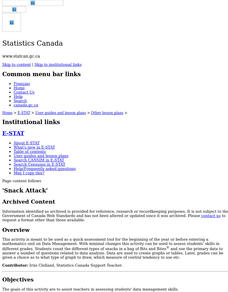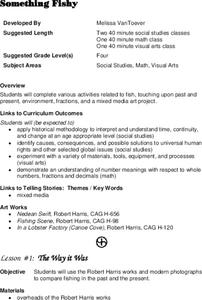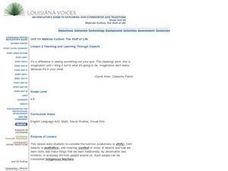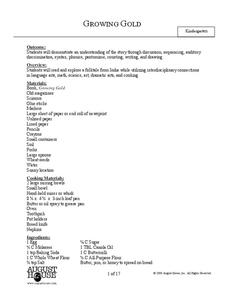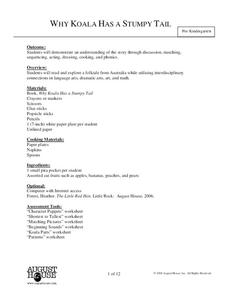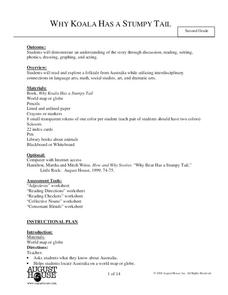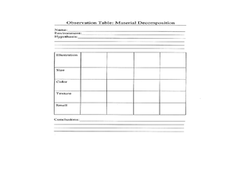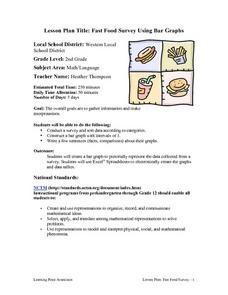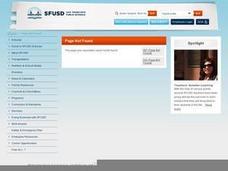Curated OER
Wild Things Are Here
Students engage in a literature study for the book Where The Wild Things Are. The skill of prediction is practiced as they preview the story as a whole class. The teacher models reading fluency, pronunciation, and phonetic skills while...
Curated OER
Patterns
Second graders create an ABAB pattern with their name. In this early elementary math instructional activity, 2nd graders first model their names in an ABAB pattern with unifix cubes. They then recreate the pattern using letter stamps on...
Curated OER
The Robot Artist--Aaron
This is a creative multidisciplinary lesson which will involve students in art, technology, and psychology. Students learn about Harold Cohen who created a robot programmed to create art. Students will also enjoy the sand pendulum...
Curated OER
Snack Attack
Students design charts, tables, graphs, and pictographs to analyse the types of snacks in a bag.
Curated OER
The First Texans
Fourth graders discover the different groups of people who colonized Texas. They research their way of life and create an informative and creative booklet.
Curated OER
TE Lesson: Habitat Mapping
Middle schoolers examine the current technologies used in mapping resources in the marine environment. They look at remote sensing, sounding, and underwater vehicles. They examine image from the benthic habitat produced by the GIS in...
Curated OER
Something Fishy
Fourth graders study the Robert Harris works and modern photographs. They compare fishing in the past and the present. They use their knowledge of equivalent fractions to play a version of the game "Go Fish".
Curated OER
Special Edition Newspaper on the Trial of Julius Caesar
Tenth graders research the multiple perspectives held by the participants in the trial relative to the conduct and outcome of the trial. Practice writing pertinent and penetrating interview questions for oral interviewing. Take a...
Curated OER
Why is a salt marsh important?
Middle schoolers discuss the salt marsh. They define the following terms: habitat, water, land and air. Students work in small groups. They are asked why are they going to a salt marsh? Middle schoolers discuss whose habitat is it at...
Curated OER
Teaching and Learning Through Objects
Students identify and interpret the function, usefulness or utitlity, form, beauty or aesthetics, and meaning, context or story, of objects and how they learn new skills and make things that they learn traditionally, by observation and...
National First Ladies' Library
On the Road, on the Sea, in the Air: Women and Transportation
Students research women who made history in development of different forms of transportation, including boats, railroads, automobiles, airplanes, and space shuttles, and create timeline/collage depicting some of their contributions.
Curated OER
Pennsylvania Watersheds
Students identify the major watersheds of Pennsylvania. In this forestry lesson, students learn what a watershed is and are assigned one of the major watersheds of Pennsylvania. Groups then need to determine the boundaries of the...
Curated OER
Anansi Goes To Lunch
Students read and explore a folktale from West Africa. In this folktale lesson, students read the book Anansi Goes to Lunch and discuss facts about spiders. Students sing the song "The Itsy Bitsy Spider" and complete several included...
Curated OER
Growing Gold
Young scholars read and explore a folktale from India. In this folktale activity, students read the book Growing Gold and discuss the events from the tale. Young scholars complete a phonics worksheet which incorporates the rhyming words...
Curated OER
Why Koala Has A Stumpy Tail
Students practice reading comprehension of an Australian folktale. In this Australian folktale lesson, students read the story, Why Koala Has a Stumpy Tail, before completing retells with character puppets, discussing friendship, and...
Curated OER
Why Koala Has a Stumpy Tail
Second graders explore Australian folktales. In this folktales lesson, 2nd graders gain knowledge about Australia and it's animals by reading books and discussion. Students find the adjectives in the book and write what they describe....
Curated OER
Slow Rot or Not?
Fifth graders examine how environmental factors affect decomposition. In this decomposition lesson plan, 5th graders experiment with the decomposition of grapes in five different environmental settings. They look at images of items that...
Curated OER
How Do You Know A Panther Was Here?
Students research the signs that panthers leave. In this panther track activity, students conduct Internet research into the signs that panthers leave such as tracks, scat, scrapes, and scratches. They make a three-dimensional poster...
Curated OER
Strawberry Girl: Lesson 3 - Trains, Sails, and Trails
Students read two chapters of Strawberry Girl by Lois Lenski and complete activities about Florida's transportation history. In this literacy and economics lesson, students read two chapters of the book, talk about their journal entries,...
Curated OER
Photosynthesis and Cell Respiration
Fifth graders participate in scientific inquires regarding the concepts of photosynthesis and cell respiration. In this photosynthesis and cell respiration lesson, 5th graders describe the process of photosynthesis with relation to...
Curated OER
Business Cards
Students follow step-by-step instructions to create a business card. They experiment with a variety of fonts and word processing features to create a business card and then design and produce an original business card.
Curated OER
Information Fluency
Third graders pretend a major trading card company has asked them to help gather information on animals who live in the rainforest. In groups, they select an animal and use the sources given to them to gather the information. They create...
Curated OER
Fast Food Survey Using Bar Graphs
Second graders conduct survey and sort data according to categories, construct bar graph with intervals of 1, and write a few sentences about their graphs.
Curated OER
Research Report on Earth Science Topics
Sixth graders are given a variety of Earth Science topics which be covered during the year. They select one of their choices to research and work in class and at home to meet the guidelines for their report.





